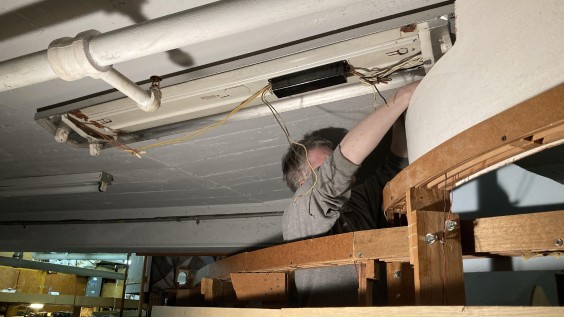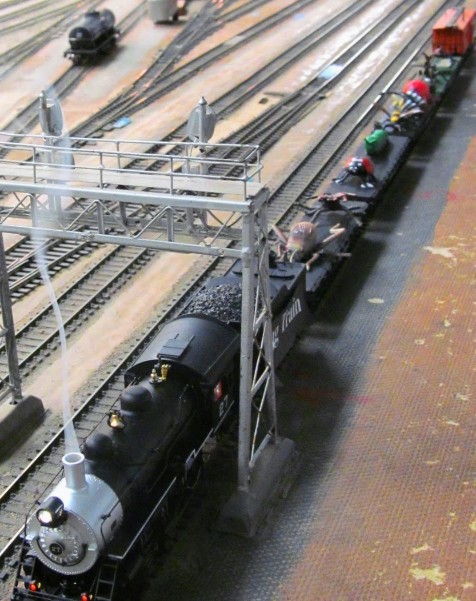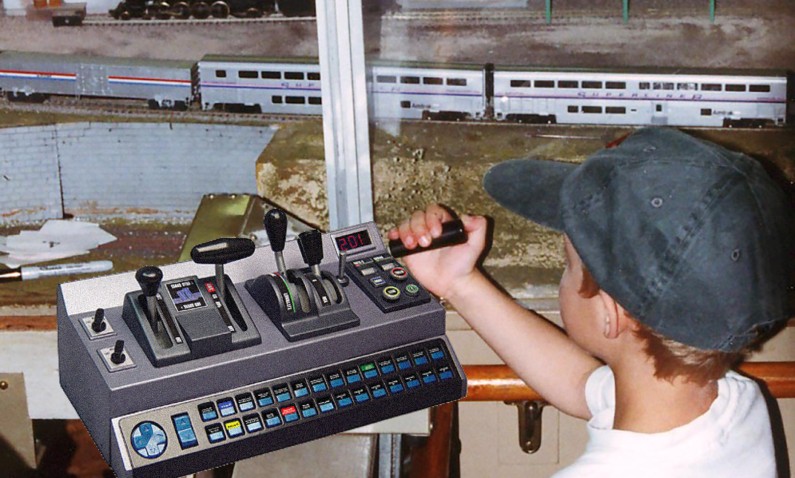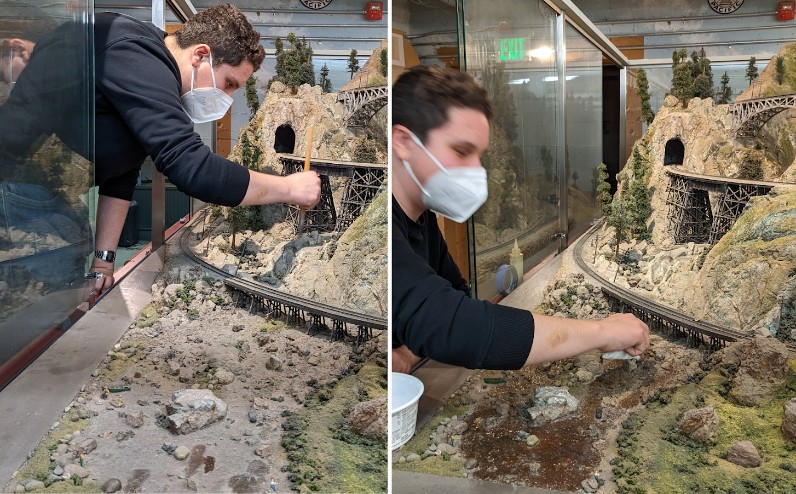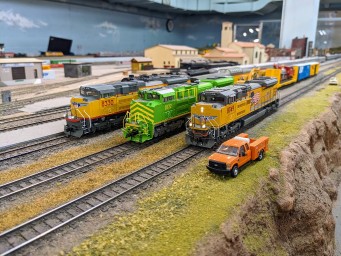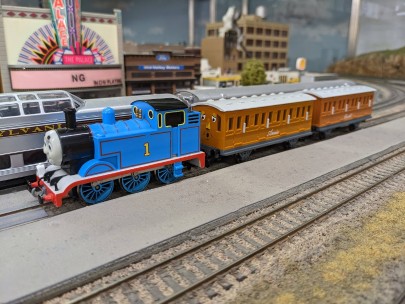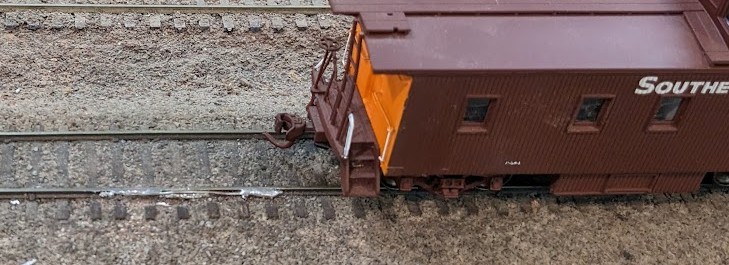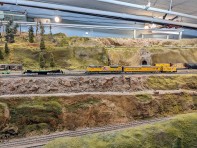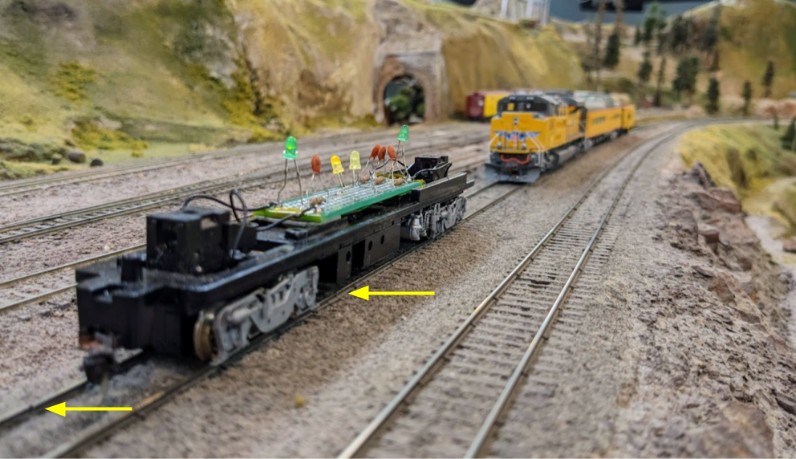The Randall Museum in San Francisco hosts a large HO-scale model railroad. Created by the Golden Gate Model Railroad Club starting in 1961, the layout was donated to the Museum in 2015. Since then I have started automatizing trains running on the layout. I am also the model railroad maintainer. This blog describes various updates on the Randall Museum Model Railroad and I maintain a separate tech blog for all my electronics & software not directly related to Randall.
2023-04-30 - Maintenance: Lights!
Category RandallWith Orion and Allen, we fixed the lighting on top of the Richmond yard. This area had been fairly dark for a while since one of the fixtures did not work, and changing the other one required some acrobatics. Orion took care of changing the dead fluorescent lights by crawling on the yard to change one of the tubes!
The middle fixture had not been working for a while. It’s one of the 60s-era ballasts that is both antiquated and dead.
It took quite time and effort to remove the obsolete fixture:
We replaced it with a Lithonia CMNS L48 2LL (80 CRI, 4500 lumens, 4000 K).
The area with the new lights in place:
Click here to continue reading...
2023-04-14 - UP 8330 Unstoppable
Category RandallThe little saga with the new Walthers Mainline SD70ACe continues as UP 8330 today totally failed to stop while running under automation and kept circling around the layout, unsupervised.
That was the initial issue with these decoders out of the box and it was supposedly fixed by the first firmware update. Apparently not quite. That’s not promising.
Like ScaleTrains, these Walthers use the new ESU "Essential Sound Unit" decoder and so far I have been less than impressed by this decoder. I don’t care that it has less features -- I don’t need any of the features that are missing. What I care about is solid reliability, and I’m afraid this decoder seems to have skipped the QA line for now.
I shall note that these decoders do not even have a product support page on the ESU website. It feels like a half-baked product. Apparently each OEM has their own unimpressive OEM-specific page to list CVs instead. In the Walthers case, it’s a random footnote in the engine’s listing. That is not a practice I like, and I will make sure to not select any more engines with this type of decoder in the near future (or at least till they iron out all the bugs).
2023-04-08 - Museum Bug Day
Category RandallOne of the most popular events at Randall Museum is Bug Day.
For the occasion, Jim and Orion ran a dedicated “bug train”:
We’re happy to announce that today, and today only, we’ll be running a fully staffed Junior Engineer Day at the Randall Museum Model Railroad.
To do so, we have acquired the latest most realistic locomotive controller from Walthers, the RailDriver Desktop Cab Controller.
However this controller requires a Windows XP computer. Since we don’t have that (our automation is all Linux-based for 24/7 maximum reliability), we need patrons to provide their own genuine CD-ROM of Windows XP with their own activation code for us to load it on our computers before they can run.
2023-03-26 - Spring Cleaning
Category RandallOrion is leading a “spring cleaning” project. While I vacuumed the banisters behind the glass doors, Orion took on dusting off the water stream next to the Sultan canyon:
The water stream, before vs after.
We’re proceeding cautiously. There are some little details (fishermen, boats, etc) that we don’t want to damage.
I also dusted the roof of the buildings on the Branchline (YouBet and Bear Creek) while he was dusting off a bit of the Fairfield area to get a sense of the task.
We decided our next move is to take care of the entire Fairfield Industrial town. Once we’re more confident with our techniques (as in “do not destroy any of the delicate structures”), we’ll deal with the larger Stockton town another day when Allen is also available.
Recently I’ve mostly spent time at home continuing my software development for Conductor 2 and SDB as well as working on electronics projects that may serve for the Randall layout later.
Yesterday I swapped #1072 for #1067 on the automated freight train:
I should try to rotate the engines more often. #1072 was getting a bit sluggish. I need to open it and lubricate all gears and axles.
I’ve also added these two little trolleys here in Fairfield:
The image above clearly shows how much we need to dust the layout. Orion is going to drive that effort next week-end. Once our dusting effort is done, I want to spend a bit more time decorating the unused track.
These two trolleys in the image above are part of a donation we recently got. There are a few interesting buildings and rolling stock I want to display. I still need to go through the boxes, which is going to take some time. The rolling stock is all DC and I can’t run it on our DCC track, but it still makes for some decent static display, especially if we can keep it on a rotation.
Most of the donated rolling stock is Tycho trains, which to be honest are not exactly the most detailed around. So the purist railroaders may just snobbily pout when they see that; however I think our little young visitors and their parents will appreciate the material just quite right -- I, for one, enjoy these old-fashion no-thrills HO rolling stocks. They are colorful and offer quite some variety from the modern too-much-life-like equipment.
My goal is to have enough variety so that we can rotate the displayed items once in a while, as there are a lot of young visitors who just come back regularly and it would be nice if they get to see different things once in a while.
A few updates here. The Walthers UP 8749 was struggling a bit recently, and I swapped it with the new Walthers UP 8330 engine:
I got two of these engines a few months ago to place them on the mainline automation, and it had been a little bit of a saga, so it’s nice to have finally completed that task. Integrating UP 8330 in the automation script was fairly easy, that only took me an hour or two.
I’ve also tried to apply a bit of ATF to clean the track used by the UP engine, and now 1072 is struggling in the large curve after T311. I don’t think it’s a coincidence. Normally I’d go in there and scrub the track with the cleaning wand but this area is out of reach. I’ll have to create a makeshift extension for the cleaning wand some day. In between, I’ve added one of the cleaning pad cars to the freight train, hoping that will slowly clean the track:
I’ve added this currently static display in front of the Stockton Station, with the engine being a temporary DC one courtesy of Orion:
We’ll see who notices :-) More on that one later.
Two noteworthy changes this week-end. One day everything is fine, and the next day both the Mainline and Branchline decide to have problems at the same time. Oh well.
That mainline solder fix I did couple weeks ago already broke, so I went back and tried to do a better job at it:
Second repair on the B321 block. Read the details here.
On the Branchline side, SP GP9 #3566 decided to stop cooperating. Engine had been working fine for a couple weeks and suddenly it would get stuck, with one of the trucks binding on one of the dual-gauge turnouts. That’s fairly unusual. Most of the time it’s the little coupler “hose” that gets stuck, but here it was one of the wheels bumping on some kind of invisible thing. The Branchline unfortunately features dual-gauge tracks, which makes the turnouts ridiculously mechanically complex, and for some reason the GP9 truck was getting stuck there but oddly enough only from time to time. Trying to clean the offending turnout didn’t help, and it’s intermittent so I don’t think it’s a debris issue.
So I decided it was time for a change again. And now we have this on the Branchline:
Amtrak EMD F40PH (Rapido) on the Branchline.
The engine is one of the two Rapido Amtrak F40PH we have. Here it is in action:
Click here to continue reading...
Affected |
Mainline B321 close to Turnout T322. |
Description |
Dead spot on Mainline B321. |
Summary Fix |
Fix bad track joiner. |
Description of Issue
Recently we were back at having the automation freight train “hesitate” on block B321, and yesterday the passenger automation train totally stopped dead on that block:
We did a previous fix on the block B321, the issue was a broken solder join. On the track schematics, today’s repairs were performed in the same vicinity, but interestingly this time we had breaks on both rails:.
I tried to use the Dead Spot Detection car, and it correctly identified the dead part of the track, but the rail breaks themselves were quite subtle to see:
The breaks themselves were actually just that -- literally broken rails with I believe likely metal joints, but it’s really hard to tell. I could not detect any trace of solder on the metal joints:
Click here to continue reading...
